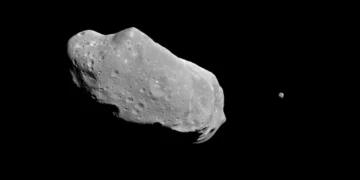NASA has issued a fascinating alert that’s causing quite a buzz among the astronomy community. An asteroid the size of a house, known as 2024 TH3, is making a close approach to Earth, coming within 192,000 miles of our planet and is expected to make its close approach to Earth on October 15, 2024 This distance, closer than the moon’s current orbit, offers astronomers a unique opportunity to study Near-Earth Objects (NEOs) more closely. Let’s dive into the science behind this asteroid encounter, why it’s significant for planetary defense, and what we can learn from these near-space visitors.
What Are Near-Earth Objects (NEOs)?
Near-Earth Objects (NEOs) are asteroids or comets that come within 120 million miles of the Sun and can be pulled closer to Earth due to the gravitational forces of nearby planets. NASA tracks thousands of these objects using a variety of telescopes and radar systems. But not all NEOs are the same size or pose the same level of threat. The key to their significance lies in their size, speed, and how closely they pass by Earth.
NEOs like 2024 TH3, which is comparable in size to a house, give scientists valuable information without posing any immediate danger. According to NASA’s Jet Propulsion Laboratory (JPL), 2024 TH3 will pass Earth at a distance of 192,000 miles—48,000 miles closer than the moon. This proximity allows for precise measurements and observations, offering insights that could prove crucial in developing future defense systems to prevent potential asteroid impacts.
The Asteroids Headed Our Way
NASA has identified three celestial bodies currently heading towards Earth’s orbit, with 2024 TH3 being the closest of the trio. Alongside 2024 TH3, the other two asteroids are 2021 TK11, roughly the size of a bus, and 2024 TA12, a smaller object measuring around 14 feet. Although these space rocks will come near Earth, NASA has confirmed they pose no threat. Their proximity, however, makes them valuable subjects for study.
Asteroids are not just passive objects. They hold clues about the formation of the solar system and contain materials that date back to its origins. The study of these rocks gives astronomers a way to learn about the early solar system and understand the forces at work during its formation.
A Learning Opportunity for Planetary Defense
Why is this encounter important? These near-Earth flybys offer NASA and other space agencies an excellent opportunity to test and refine their asteroid detection and tracking systems. As the size and proximity of these NEOs increase, scientists become more interested in finding ways to ensure that any potential impact with Earth can be detected early.
NASA’s Planetary Defense Coordination Office (PDCO) plays a pivotal role in safeguarding Earth from asteroid impacts. Established in 2016, the PDCO monitors and assesses potential impact threats from NEOs, ensuring early warnings can be issued. The data collected from events like the 2024 TH3 flyby will be vital for improving the detection and tracking of these space objects.
An asteroid passing this close to Earth reminds us of the dangers posed by rogue space objects. While the likelihood of a catastrophic impact is small, it’s not impossible. NASA’s data collection from these events helps improve prediction models that track the movement of NEOs and estimate their future trajectories.
Future-Proofing Against Asteroid Threats
While the 2024 TH3 asteroid poses no threat, the existence of larger, more dangerous asteroids makes planetary defense a pressing concern. To prepare for worst-case scenarios, NASA is working on innovative technologies designed to monitor and mitigate asteroid impacts.
The Near-Earth Object Surveyor (NEO Surveyor), slated for launch in 2027, represents a significant advancement in NEO detection technology. This telescope will specialize in spotting potentially hazardous asteroids that come within 30 million miles of Earth’s orbit. The aim is to identify objects large enough to cause significant damage and to calculate their risk of impacting our planet. The development of the NEO Surveyor underscores NASA’s commitment to defending Earth from cosmic threats.
Another recent breakthrough in planetary defense came from NASA’s successful Double Asteroid Redirection Test (DART) mission, which tested whether it’s possible to change an asteroid’s trajectory by deliberately crashing into it. While DART targeted a small moonlet of the asteroid Didymos, the mission demonstrated a potential solution for deflecting a future asteroid that could pose a serious risk to Earth.
Asteroid Impacts: Learning from the Past
Asteroids have impacted Earth before, and they will likely do so again in the future. The asteroid that wiped out the dinosaurs 66 million years ago is perhaps the most famous example of a catastrophic impact event. However, more recent impacts, such as the 2013 Chelyabinsk meteor explosion over Russia, remind us that even smaller asteroids can cause significant damage.
NASA’s continued monitoring of NEOs helps scientists refine their predictions and prepare for future threats. For instance, the asteroid Apophis, which will make a close flyby of Earth in 2029, has been the subject of much study. While initial estimates suggested it could collide with Earth, recent data shows that it will safely pass by.
Still, the question remains: What if an asteroid were on a collision course with Earth? That’s where planetary defense comes into play. By studying NEOs like 2024 TH3 and testing technologies such as the DART mission, NASA is building a toolkit to protect Earth from potentially hazardous asteroids.
Conclusion: The Value of Near-Earth Objects
The flyby of asteroid 2024 TH3 is a timely reminder of the importance of space observation and planetary defense. While this asteroid and others in its cohort pose no danger, their close approach to Earth provides valuable research opportunities. From studying their composition to improving tracking systems, scientists are working to ensure that we are prepared for any future threats.
NASA’s continued development of asteroid monitoring systems, including the upcoming NEO Surveyor, ensures that humanity is better equipped to handle any space rocks headed our way. These efforts not only help protect Earth but also expand our knowledge of the solar system’s origins.



















